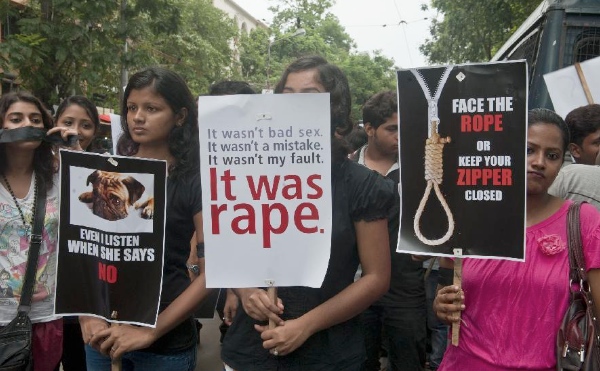
“A fifteen year old girl gangraped…”
“A four year old girl raped by neighbour dies…”
“A young woman commit suicide, in-laws used to torture for dowry…”
Did the above headlines shock you?
In India, apparently these are everyday news, and unfortunately, it seems people are not even shocked to read them any more. Such violences against a person based on its gender are now being called as Gender-based Violence (GBV). EIGE defines GBV as “violence directed against a person because of their gender.”
The phenomenon of Gender-based violence has been found to be deeply rooted in gender inequality, and continues to be one of the most notable human rights violations within all societies. Both women and men experience gender-based violence but the majority of victims are women and girls.
Amnesty International India have also found that gender-based violence against women and girls in India is widespread. And despite some progressive legislative measures in recent years, brought about under pressure from women’s rights movements and the media and public campaigns, many women continue to experience discrimination and violence in their everyday lives.
Gender-based violence is not, however, restricted to any one domain, it takes place in both public and private spheres. And it often goes under-reported as a result of systemic and social barriers along with inefficient formal mechanisms to address it.
According to National Family Health Survey (NFHS-4) 2015-16, 30 percent women in India in the age group of 15-49 had reportedly experienced physical violence since the age of 15. The survey also further revealed that 6 percent women in the same age group had experienced sexual violence at least once in their lifetime. And more significantly, about 31 percent of married women had experienced physical, sexual or emotional violence by their spouses. The survey also clearly highlighted that domestic violence is one of the most prevalent form of violence against women in India.
GBV can cause not only direct and long-term physical and mental health consequences but also cripple a woman socio-economically. Women who have experienced such violence have been found to be at risk of unwanted pregnancies, maternal and infant mortality, and sexually transmitted infections, including HIV. Also women who experience violence from their partners are less likely to earn a living and are less able to care for their children or participate meaningfully in community activities or social interaction in society. Moreover in many cultures, women who are raped or sexually abused are stigmatised and isolated, this impacts not only their well-being, but also their social participation, opportunities and quality of life.
Many feminist scholars and activists argue that the widespread socio-economic dependency of women underlines this unbalanced equation with their husbands and other family members. The fear of social exclusion and banishment, and the lack of effective response to violence against women contributes significantly in this rising trend.
Moreover, the indicators of violence against women are a reflection of the structural and institutional inequality that is a reality for most women in India. Many incidences of violence are supported by the persistence of patriarchal gender and social norms prevalent in Indian society.
Unfortunately this rising trend is still not indicative of the complete picture of gender based violence in India. According to reports, India’s average rate of reported rape cases is about 6.3 per 100,000 of the population. However, this differs in places like Sikkim and Delhi, which have rates of 30.3 and 22.5, respectively, while Tamil Nadu has a rate of less than one.
The interpretation of state-wise difference also depends on ‘reported’ cases, and could suffer from under-reporting. According to a recent report by Livemint, about 99 percent cases of sexual violence go unreported. The extent of under-reporting tends to be higher on average in states with a low female literacy. In states like Bihar, Uttar Pradesh and Jharkhand, less than 0.5 percent of incidents of violence against women were reported.
The increasing frequency of gory cases that are reported or sometimes not reported by the media, is also reflective of the discriminatory mentality against women and girls in Indian society, which somewhere safeguard harmful traditional and patriarchal norms instead of questioning them.
There are no dearth of laws and policies around various aspects of GBV in India but despite the well laid out policies and laws to prevent Gender Based Violence, India was ranked as one of the world’s most dangerous countries for women by Thomson Reuters Foundation’s annual poll.
Feminists and activists argue, the persistence of harmful practices, pervasive gender stereotypes and deeply entrenched patriarchal social and cultural norms is a serious concern in the country. They, therefore, call for a comprehensive effort to address issues around objectification of women and their treatment as the “weaker sex”, specially in schools or university, at work, in the family, in the community and in print and electronic media.
There is a need to introduce policies and programmes which support not only the health of women and girls, but also their socio-economic development. Moreover, there must be a strong focus on girls and the prevention of sexual and gender-based violence, including harmful traditional practices that compromise their health and limit development in other areas of their lives.
Adding on to that there’s a need of bringing changes to the existing framework to make law more accessible and responsive. Barring few, most of the existing policy frameworks are reactive to the situation once the act of violence has taken place and thus are limited in the efforts being made to address the GBV cases. Further more, some of the key areas that requires attention would be :
- Addressing the deeply entrenched patriarchal attitudes of the police, lawyer and other judicial officers that continues to contribute to low reporting and conviction rates.
- Bridging the gap between GBV laws and its correlated areas such as legal rights to property, land, inheritance, employment and income, that allows a woman to walk out of an abusive relationship and specific emphasis on political and economic participation of women.
- Recognize sexual and reproductive health and rights by promotion and protection of women’s right to have control and decide freely over matters related to their sexuality, including sexual and reproductive health, family-planning choices and access to comprehensive sexuality education.
- And lastly, reclaiming the spaces for women to increase their presence in visibility through political and economic participation and diversifying their engagement in non-traditional sectors.













